

What Are Gravitons? Receive emails about upcoming NOVA programs and related content, as well as featured reporting about current events through a science lens.
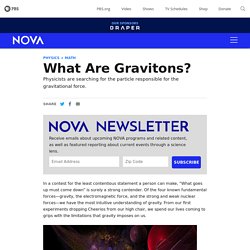
In a contest for the least contentious statement a person can make, “What goes up must come down” is surely a strong contender. Of the four known fundamental forces—gravity, the electromagnetic force, and the strong and weak nuclear forces—we have the most intuitive understanding of gravity. From our first experiments dropping Cheerios from our high chair, we spend our lives coming to grips with the limitations that gravity imposes on us. Support Provided ByLearn More. Futurism. What Does Gravity Look Like?
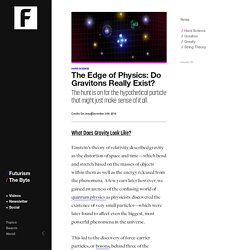
Graviton. In theories of quantum gravity, the graviton is the hypothetical quantum of gravity, an elementary particle that mediates the force of gravity.
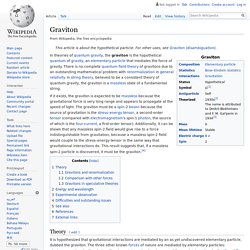
There is no complete quantum field theory of gravitons due to an outstanding mathematical problem with renormalization in general relativity. In string theory, believed to be a consistent theory of quantum gravity, the graviton is a massless state of a fundamental string. Theory[edit] It is hypothesized that gravitational interactions are mediated by an as yet undiscovered elementary particle, dubbed the graviton. Higgs mechanism. In the Standard Model of particle physics, the Higgs mechanism is essential to explain the generation mechanism of the property "mass" for gauge bosons.
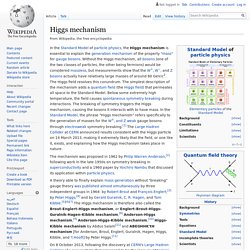
Without the Higgs mechanism, all bosons (one of the two classes of particles, the other being fermions) would be considered massless, but measurements show that the W+, W−, and Z bosons actually have relatively large masses of around 80 GeV/c2. The Higgs field resolves this conundrum. The simplest description of the mechanism adds a quantum field (the Higgs field) that permeates all space to the Standard Model. Below some extremely high temperature, the field causes spontaneous symmetry breaking during interactions. Peter Higgs. British physicist Peter Ware Higgs CH FRS FRSE FInstP (born 29 May 1929) is a British theoretical physicist, emeritus professor in the University of Edinburgh,[5][6] and Nobel Prize laureate for his work on the mass of subatomic particles.[7]

Six Things Everyone Should Know About Quantum Physics. Quantum physics is usually just intimidating from the get-go.
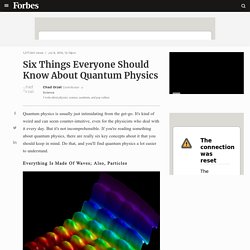
It's kind of weird and can seem counter-intuitive, even for the physicists who deal with it every day. But it's not incomprehensible. If you're reading something about quantum physics, there are really six key concepts about it that you should keep in mind. Do that, and you'll find quantum physics a lot easier to understand. Everything Is Made Of Waves; Also, Particles. Quantum Theory and the Uncertainty Principle - The Physics of the Universe. Main Topics > (introduction) However, some of its findings and principles are distinctly counter-intuitive and fiendishly difficult to explain in simple language, without resorting to complex mathematics way beyond the comfort level of most people (myself included!).

Quantum Physics May Be Even Spookier Than You Think. It is the central question in quantum mechanics, and no one knows the answer: What really happens in a superposition—the peculiar circumstance in which particles seem to be in two or more places or states at once?

Now, in a new paper a team of researchers in Israel and Japan has proposed an experiment that could finally let us say something for sure about the nature of this puzzling phenomenon. Their experiment, which the researchers say could be carried out within a few months, should enable scientists to sneak a glance at where an object—in this case a particle of light, called a photon—actually resides when it is placed in a superposition. And the researchers predict the answer will be even stranger and more shocking than “two places at once.”
The classic example of a superposition involves firing photons at two parallel slits in a barrier. For decades researchers have stalled at this apparent impasse. But one needn’t take this strange notion literally. Definition, Development, & Equations. Basic concepts and methods Bohr’s theory, which assumed that electrons moved in circular orbits, was extended by the German physicist Arnold Sommerfeld and others to include elliptic orbits and other refinements.

Attempts were made to apply the theory to more complicated systems than the hydrogen atom. What Is Quantum Mechanics? Quantum Physics Defined, Explained. Quantum mechanics is the branch of physics relating to the very small.
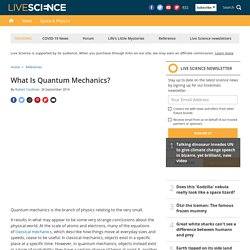
It results in what may appear to be some very strange conclusions about the physical world. At the scale of atoms and electrons, many of the equations of classical mechanics, which describe how things move at everyday sizes and speeds, cease to be useful. In classical mechanics, objects exist in a specific place at a specific time. Quantum mechanics. Wavefunctions of the electron in a hydrogen atom at different energy levels. Quantum mechanics cannot predict the exact location of a particle in space, only the probability of finding it at different locations.[1] The brighter areas represent a higher probability of finding the electron. Quantum mechanics (QM; also known as quantum physics, quantum theory, the wave mechanical model, or matrix mechanics), including quantum field theory, is a fundamental theory in physics which describes nature at the smallest scales of atoms and subatomic particles.[2] Quantum mechanics gradually arose from theories to explain observations which could not be reconciled with classical physics, such as Max Planck's solution in 1900 to the black-body radiation problem, and from the correspondence between energy and frequency in Albert Einstein's 1905 paper which explained the photoelectric effect.
History[edit] In 1838, Michael Faraday discovered cathode rays. Where h is Planck's constant. Coulomb potential. Elementary particle. In particle physics, an elementary particle or fundamental particle is a particle whose substructure is unknown, thus it is unknown whether it is composed of other particles.[1] Known elementary particles include the fundamental fermions (quarks, leptons, antiquarks, and antileptons), which generally are "matter particles" and "antimatter particles", as well as the fundamental bosons (gauge bosons and Higgs boson), which generally are "force particles" that mediate interactions among fermions.[1] A particle containing two or more elementary particles is a composite particle. Everyday matter is composed of atoms, once presumed to be matter's elementary particles—atom meaning "indivisible" in Greek—although the atom's existence remained controversial until about 1910, as some leading physicists regarded molecules as mathematical illusions, and matter as ultimately composed of energy.[1][2] Soon, subatomic constituents of the atom were identified.
Overview[edit] Main article: Standard Model. General relativity. Theory by Albert Einstein, covering gravitation in curved spacetime Slow motion computer simulation of the black hole binary system GW150914 as seen by a nearby observer, during 0.33 s of its final inspiral, merge, and ringdown. The star field behind the black holes is being heavily distorted and appears to rotate and move, due to extreme gravitational lensing, as spacetime itself is distorted and dragged around by the rotating black holes.[1] General relativity (GR, also known as the general theory of relativity or GTR) is the geometric theory of gravitation published by Albert Einstein in 1915 and the current description of gravitation in modern physics.
General relativity generalizes special relativity and supersedes Newton's law of universal gravitation, providing a unified description of gravity as a geometric property of space and time, or spacetime. Einstein's theory has important astrophysical implications. History[edit] From classical mechanics to general relativity[edit] Theory of relativity. The theory of relativity usually encompasses two interrelated theories by Albert Einstein: special relativity and general relativity.[1] Special relativity applies to elementary particles and their interactions, describing all their physical phenomena except gravity. General relativity explains the law of gravitation and its relation to other forces of nature.[2] It applies to the cosmological and astrophysical realm, including astronomy.[3] The theory transformed theoretical physics and astronomy during the 20th century, superseding a 200-year-old theory of mechanics created primarily by Isaac Newton.[3][4][5] It introduced concepts including spacetime as a unified entity of space and time, relativity of simultaneity, kinematic and gravitational time dilation, and length contraction.
In the field of physics, relativity improved the science of elementary particles and their fundamental interactions, along with ushering in the nuclear age. Matrix (mathematics) Two-dimensional array of numbers with specific operations The m rows are horizontal and the n columns are vertical. Each element of a matrix is often denoted by a variable with two subscripts. Field. Edward Witten. Edward Witten (born August 26, 1951) is an American theoretical physicist and professor of mathematical physics at the Institute for Advanced Study in Princeton, New Jersey.
M-theory. Superstring theory. Explanation & Definition. String theory. Maybe We Could "See" a Singularity After All. Black Holes Must Have Singularities, Says Einstein's Relativity. Inside a black hole, the spacetime curvature is so large that light cannot escape, nor can particles, under any circumstances. Singularities and Black Holes.
Beyond the black hole singularity. Our first glimpses into the physics that exist near the center of a black hole are being made possible using "loop quantum gravity"—a theory that uses quantum mechanics to extend gravitational physics beyond Einstein's theory of general relativity. Loop quantum gravity, originated at Penn State and subsequently developed by a large number of scientists worldwide, is opening up a new paradigm in modern physics. Gravitational singularity. Singularities - Black Holes and Wormholes - The Physics of the Universe. Lee Smolin. Second Law of Thermodynamics. Second Law of Thermodynamics. Second law of thermodynamics. Conformal cyclic cosmology. Penrose claims to have glimpsed universe before Big Bang. New evidence for cyclic universe claimed by Roger Penrose and colleagues.
Roger Penrose. Eternal inflation. If Gravitational constant G; Planck's constant h and velocity of light c are fundamental quantities; the dimension of radius of gyration will be?? Planck constant. The Origin of the Number Zero. 0. William Blake. Rabindranath Tagore. Freeman Dyson (1923-) Freeman Dyson. School of Natural Sciences. Freeman Dyson.
Observer Effect – Quantum Physics. Observer effect. Quantum Theory Demonstrated: Observation Affects Reality. Observer effect. Observer effect. Observer effect. Ligo - Recherche Google. LIGO Lab. LIGO. Theory of everything. Arthur Eddington.